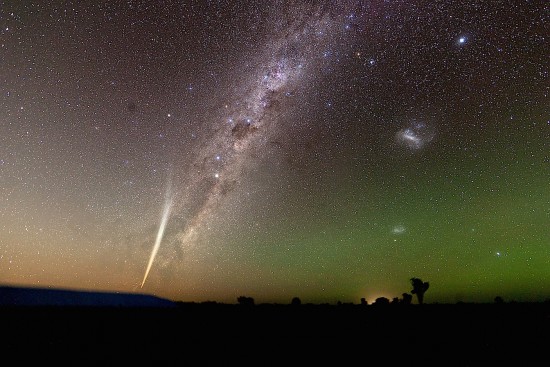Mar 16, 2016
The recent activity of comet Lovejoy puts another dent in conventional comet theory. The “dirty snowball” hypothesis should be discarded in favor of electrical activity.
Editor’s note: The Picture of the Day is on a brief hiatus, returning on March 18, 2016. Please enjoy this article from January 2015.
According to a recent press release, astronomers are surprised by the “unexpected brightening” of comet Lovejoy. Edwin Lovejoy discovered C/2014 Q2 on August 17, 2014, from Brisbane, Australia. It is a common theme among astronomers in recent years to refer to comets almost universally as “surprising” or “puzzling”. Why the confusion persists is because most scientists think of comets as icy bodies, with only a small percentage of rocky composition.
Comets spend most of their time far from the Sun where the charge density is low. Because comets move slowly, their electric charges reach equilibrium with the weak, radial solar field. As they get closer to the Sun, however, their nuclei speed into regions of increasing charge density and varying electrical flux. Polarity and charge characteristics respond to increasing solar forces, so comas (charge sheaths) form around them. Discharge jets flare up and move across the surface like the plumes of Jupiter’s moon, Io. If the charge imbalance becomes too great, the nuclei may explode like an over-charged capacitor, breaking into fragments or vanishing forever.
In a previous Picture of the Day article about the fissioning of Comet West in 1976, it was noted that comets tend to split or to undergo anomalous displays when they are approaching their farthest distance from the sun. Since conventional theories of the Solar System are based exclusively on gravity, disruptions should only occur at close approaches to the Sun, the activity of comet West was a surprise.
Comet Linear was also “mysterious”. In July of 2000 it actually blew apart. The strangest thing about its fragmentation was that it occurred at a distance of over 100 million kilometers from the Sun and not when it passed by during perihelion. As a matter of observation, the majority of cometary disruptions take place when they are far from the sun. Another counter-intuitive reflection is that so-called “sun-grazer” comets (like comet Lovejoy) do not break apart despite approaching to within 150,000 kilometers of the Sun’s surface.
The large comet, Hale-Bopp, did not obey the standard theory of cometary activity. Four years after its encounter with the Sun, in a region past Jupiter’s orbit, the comet displayed an ion tail, several jets of bright material spewing into space and a glowing coma. The “dirty snowball” theory cannot account for such activity at distances where solar energy emissions are so weak that ice will not melt.
If solar heating were responsible for cometary discharges at such distances, then all the frozen moons of Jupiter would be as dry as deserts and would look more like our own moon than the icy bodies that they are. If the Sun’s warmth was not the impetus for Hale-Bopp’s display, then what is it that provides the energy for supersonic blasts of dust and ice when it is so far away from the Sun?
If Lovejoy continues to brighten, it could explode like comet Linear, or fragment like comet Schwassman-Wachmann 3, becoming another casualty of electric discharge activity in the Solar System. Lovejoy moves out from under the constellation Lepus in early January, closing in on Andromeda by the end of the month. It should peak at around 4th magnitude, bright enough to be easily seen with binoculars.
Stephen Smith













